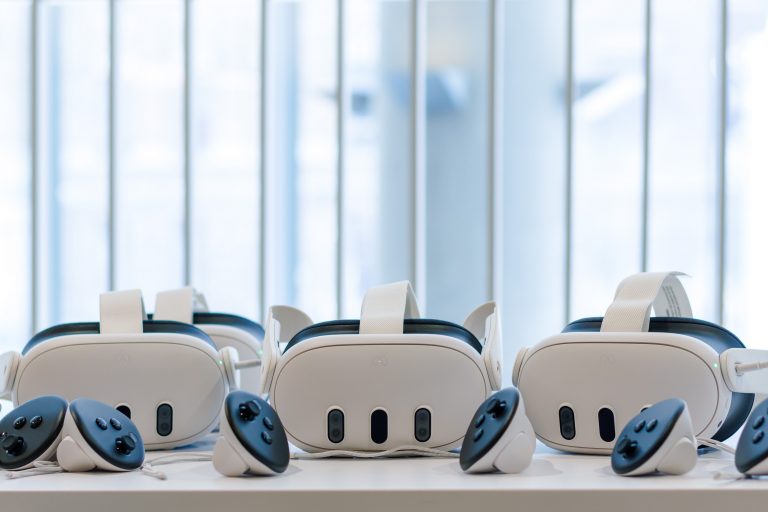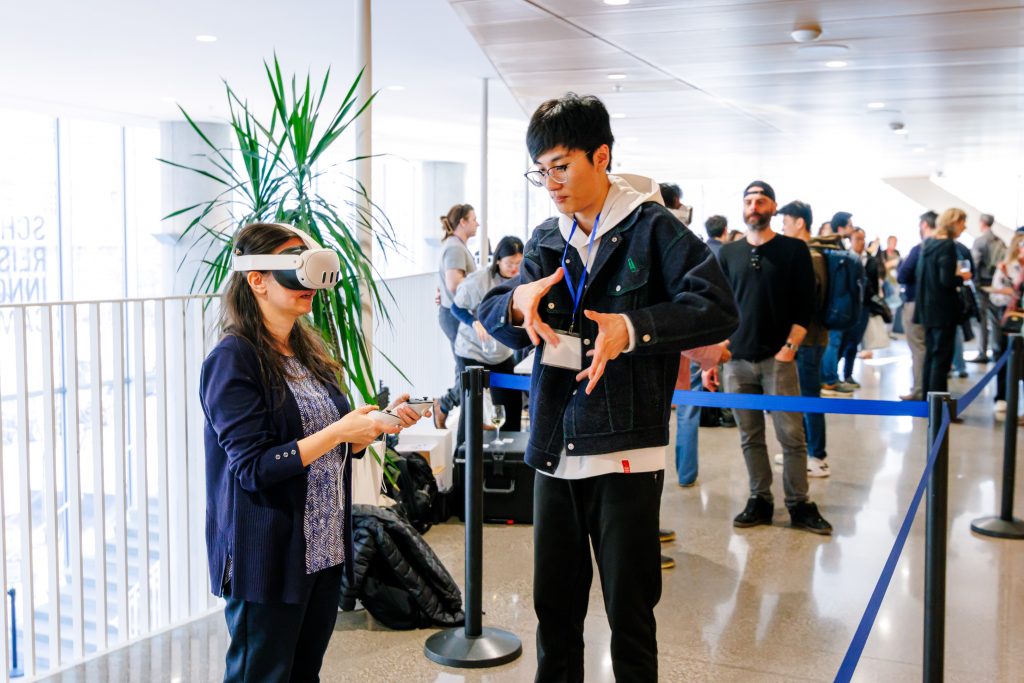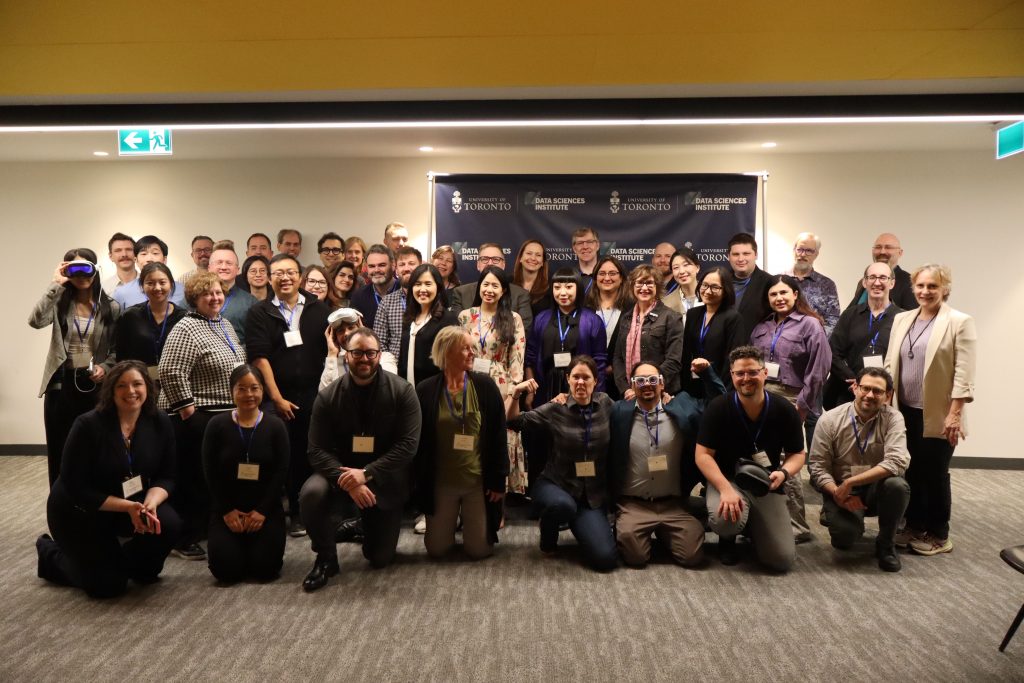The Data Sciences Institute’s (DSI) Summer Undergraduate Data Science (SUDS) Opportunities Program celebrated the achievements of its 2025 cohort with the annual SUDS Showcase – an exciting full day of research project presentations and poster sessions by 60 undergraduate students.
Designed as a marquee event to close the SUDS year of study, the Showcase provides a forum for SUDS Scholars and Supervisors to share their data science research.
Javier Mencia Ledo, SUDS 2025 Scholar, whose research Risk factors and Early Prediction of Labour Force Dropout in SLE Patients: Integrating Longitudinal Deep Learning through an LSTM RNN with Random Forests, focused on a neural network that detects early warning signs of disability in lupus patients, allowing timely support for interventions. Supervised by Professor Behdin Nowrouzi-Kia (Department of Occupational Therapy and Occupational Science, Temerty Faculty of Medicine), Javier worked in the Rehabilitation Sciences Through Occupational Research & Engagement (ReSTORE) Lab.
“Being part of SUDS has been such an invaluable experience,” said Ledo.
“I got to hear the stories and learn from incredibly talented people working in both industry and academia, and contribute to many impactful projects at the ReSTORE Lab. It confirmed that I want to pursue this career path in grad school.”

“The SUDS Showcase is a highlight, creating an opportunity for scholars, supervisors and the broader DSI community to view and discuss the various data science methods, including AI, applied across a broad range of areas,” said Professor Laura Rosella, DSI Associate Director of Education and Training.
“Under the supervision of U of T and affiliated external partner researchers, students applied data science methods and tools to research on locating genetic ancestors with ancient DNA, integrating predictive analytics into an equity dashboard and finding substructures within the Milky Way with geometric deep learning.
“Elise Corbin and Al Ali Abdulmohseen collaborated in the presentation, Piccard: An Open-Source Tool to Analyze Longitudinal Data without Geographic Harmonization, detailing the development of a Python package that applies graph networks to census data visualization and analysis. Their research was supervised by Professor Fernando Calderón Figueroa (Department of Human Geography, University of Toronto Scarborough).
“SUDS was like a dream job for me,” said Corbin. “I really enjoyed a flexible schedule, and I felt like I was doing important work that could really improve people’s lives down the line.”
“My collaborator, supervisor, and I hope to publish the results of our work as well, which is an added bonus. I recommend SUDS as the perfect opportunity to gain research experience, experience life in the data science workforce, and possibly even get published!”

(L-R) Matthew Tamura, Shan (Angelina) Zhai, Professor Shion Guha (Faculty of Information, University of Toronto) worked on the Children’s Aid Society MITACS project
SUDS provides a rich summer training experience for students from a wide variety of academic backgrounds to be exposed to and apply data science techniques in their work.
Two SUDS Scholars from the University of Toronto had the opportunity to intern at Children’s Aid Society of Toronto, thanks to Mitacs funding. This collaboration is part of the larger DSI initiative for Data-driven Decisions & Discovery: Innovation for Transformative Impact. Through these strategic partnerships, DSI connects organizations with skilled undergraduate talent to advance high-impact, data-driven projects. With Mitacs support, partners can accelerate innovation by engaging top U of T students over the summer.
“The MITACS Accelerate program has been instrumental in bridging academic research with real-world impact,” said Prof. Shion Guha (Faculty of Information and Department of Computer Science, U of T).
“For example, through our partnership with the Children’s Aid Society of Toronto, two outstanding undergraduate SUDS Scholars are contributing to data-driven solutions in the child welfare sector, gaining invaluable experience while shaping socially responsible technology.”

The 27 students from the King Abdullah University of Science and Technology (KAUST) Academy, recipients of prestigious awards from KAUST, were selected through a highly competitive process to participate in SUDS. This marks a near doubling from last year’s SUDS KAUST cohort, reflecting growing interest and momentum. KAUST specifically sought out the University of Toronto for this collaboration due to its world-renowned ranking in data science.
“The SUDS Scholars were excellent, and it was great to see them present their research, building on the data science skills they have learned this summer,” said DSI supervisor Zahra Shakeri, (Dalla Lana School of Public Health, University of Toronto).
“They worked closely with the clinician in the team and other team members to explore a timely data science problem, providing valuable insights and framing directions for future investigation.”
Along with their research projects, SUDS Scholars partake of the SUDS Cohort programming for networking, academic and professional development. This includes the Data Science@Work Series, where representatives from the private sector and government organizations share data science applications in the workplace. The scholars began in May with the DSI Data Science Bootcamp, gaining proficiency in data science skills including Unix Shell, R, Python, and machine learning.

A highlight of the 2025 Showcase was keynote speaker, Prof. Rachel Harding (Department of Pharmacology and Toxicology, Temerty Faculty of Medicine, University of Toronto; Principal Investigator, Structural Genomics Consortium), who spoke on the topic of Protein–Ligand Data at Scale: Foundations for Machine Learning in Drug Discovery. Does that work?
“The SUDS program offers a rare and powerful blend of technical training, critical thinking, and applied experience,” said Guha.
“As a faculty mentor, it’s been deeply rewarding to witness students grow into thoughtful, industry-ready researchers committed to ethical data science.
Distinction in the poster category was given to scholars Amjad Albawardi, Tabris Cao, Abdulaziz Alkharjy, Anas Alshehri and Mehtab Cheema, while Noor Khan, Matthew Tamara and Shan (Angelina) Zhai were recognized for their standout presentations.
Photos: Cormac Rea





